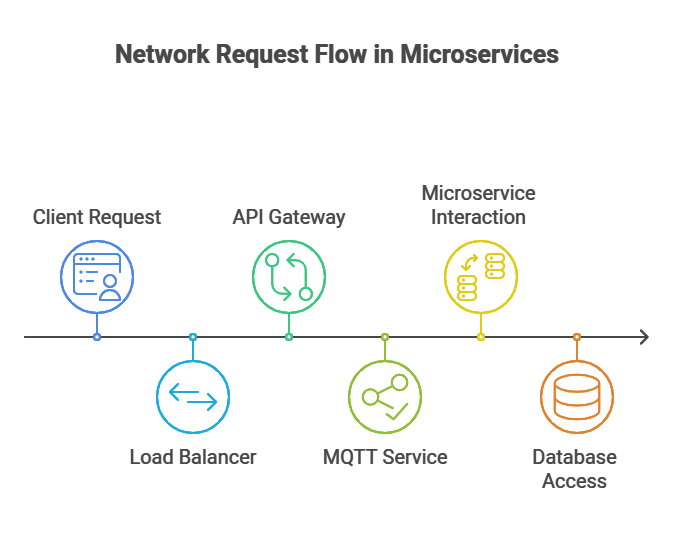Network Diagram for Client-Server Architecture with Load Balancer and MQTT Service
This document outlines the architecture of a network diagram that illustrates the flow of requests from a client through a load balancer to an API gateway, and subsequently to an MQTT service. The MQTT service facilitates communication among various microservices, each with its own dedicated database or data source. This setup is designed to enhance scalability, reliability, and efficient data handling in a microservices environment.
Network Flow Description
1. Client Request
The process begins with a client initiating a request. This could be a web application, mobile app, or any other client interface that interacts with the backend services.
2. Load Balancer
The client request is first directed to a load balancer. The load balancer's role is to distribute incoming requests evenly across multiple instances of the API gateway, ensuring no single instance is overwhelmed and improving overall system performance.
3. API Gateway
After the load balancer processes the request, it forwards it to the API gateway. The API gateway acts as a single entry point for all client requests, managing and routing them to the appropriate services. It can also handle tasks such as authentication, logging, and request transformation.
4. MQTT Service
The API gateway then communicates with the MQTT service. MQTT (Message Queuing Telemetry Transport) is a lightweight messaging protocol ideal for connecting various microservices. The MQTT service enables efficient communication between the API gateway and the microservices, allowing them to publish and subscribe to messages as needed.
5. Microservices and Databases
Each microservice connected to the MQTT service has its own specific database or data source. This architecture allows for independent scaling and management of each microservice, as they can operate and evolve without affecting others. The microservices communicate through the MQTT service, exchanging data and responding to requests as necessary.
Network Diagram

This is a very basic diagram. See below for an animated view.
Conclusion
This network diagram illustrates a robust architecture that leverages a load balancer, API gateway, and MQTT service to facilitate efficient communication among microservices. By employing this design, developers can ensure that their applications are scalable, maintainable, and capable of handling varying loads effectively.
